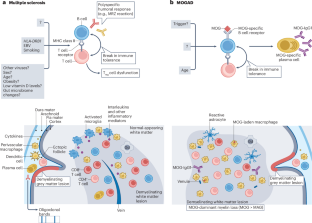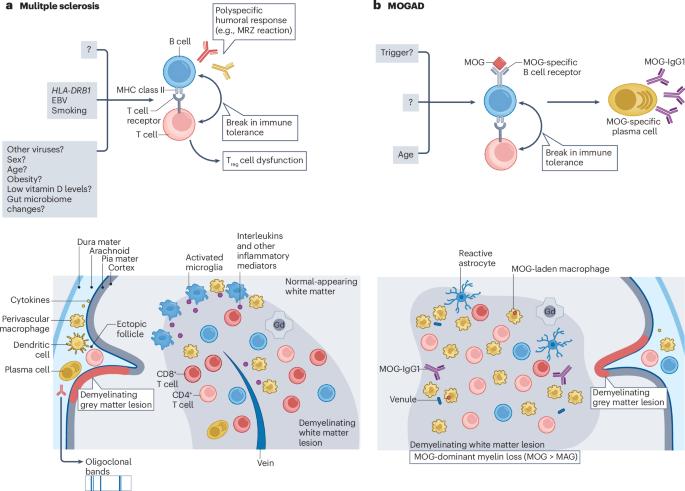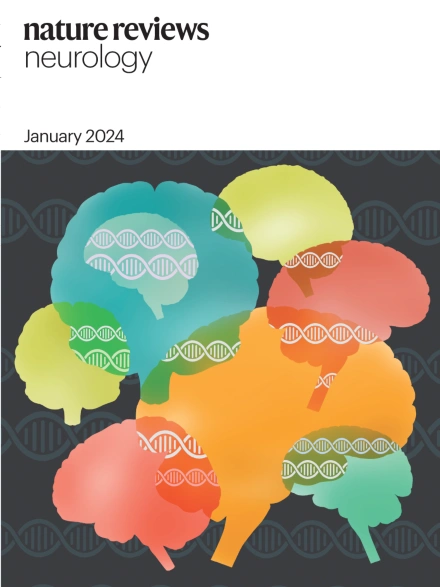MOGAD 对使用磁共振成像诊断多发性硬化症的影响
IF 28.2
1区 医学
Q1 CLINICAL NEUROLOGY
引用次数: 0
摘要
髓鞘少突胶质细胞糖蛋白(MOG)抗体相关性疾病(MOGAD)是一种免疫介导的脱髓鞘疾病,很难与多发性硬化症(MS)区分开来,因为两者的临床表型重叠,MOGAD 患者可以满足目前基于磁共振成像的多发性硬化症诊断标准。此外,作为 MOGAD 诊断重要组成部分的 MOG 抗体检测也没有标准化。由于 MOGAD 的治疗方法和长期预后与多发性硬化症不同,因此准确诊断 MOGAD 至关重要。本专家建议总结了 2022 年 5 月在英国牛津举行的多发性硬化症磁共振成像研讨会的成果,会上多发性硬化症和 MOGAD 专家对这些疾病的病理和临床特征、磁共振成像对诊断的贡献以及 MOG 抗体检测的临床应用进行了反思。我们还批判性地回顾了文献,以评估当前 MS 和 MOGAD 标准中独特成像特征的有效性。我们的结论是,专门的眼眶和脊髓成像(轴向切片)可为 MOGAD 诊断提供依据,同时也可用于鉴别诊断。我们为神经科医生和神经放射科医生提供了实用的指导,帮助他们掌握当前的 MOGAD 和 MS 标准。我们提出了一种策略,其中包括标准临床 MRI 上有用的成像判别指标,并讨论了通过非常规 MRI 序列检测到的成像特征,这些特征在区分这两种疾病方面显示出前景。本文章由计算机程序翻译,如有差异,请以英文原文为准。


The influence of MOGAD on diagnosis of multiple sclerosis using MRI
Myelin oligodendrocyte glycoprotein (MOG) antibody-associated disease (MOGAD) is an immune-mediated demyelinating disease that is challenging to differentiate from multiple sclerosis (MS), as the clinical phenotypes overlap, and people with MOGAD can fulfil the current MRI-based diagnostic criteria for MS. In addition, the MOG antibody assays that are an essential component of MOGAD diagnosis are not standardized. Accurate diagnosis of MOGAD is crucial because the treatments and long-term prognosis differ from those for MS. This Expert Recommendation summarizes the outcomes from a Magnetic Resonance Imaging in MS workshop held in Oxford, UK in May 2022, in which MS and MOGAD experts reflected on the pathology and clinical features of these disorders, the contributions of MRI to their diagnosis and the clinical use of the MOG antibody assay. We also critically reviewed the literature to assess the validity of distinctive imaging features in the current MS and MOGAD criteria. We conclude that dedicated orbital and spinal cord imaging (with axial slices) can inform MOGAD diagnosis and also illuminate differential diagnoses. We provide practical guidance to neurologists and neuroradiologists on how to navigate the current MOGAD and MS criteria. We suggest a strategy that includes useful imaging discriminators on standard clinical MRI and discuss imaging features detected by non-conventional MRI sequences that demonstrate promise in differentiating these two disorders. Myelin oligodendrocyte glycoprotein antibody-associated disease is an immune-mediated demyelinating disease that is distinct from multiple sclerosis but shares some of its characteristics. This Expert Recommendation, based on a Magnetic Resonance Imaging in MS workshop, proposes a diagnostic algorithm for the differential diagnosis of myelin oligodendrocyte glycoprotein antibody-associated disease and multiple sclerosis, using serological, imaging and clinical features.
求助全文
通过发布文献求助,成功后即可免费获取论文全文。
去求助
来源期刊

Nature Reviews Neurology
医学-临床神经学
CiteScore
29.90
自引率
0.80%
发文量
138
审稿时长
6-12 weeks
期刊介绍:
Nature Reviews Neurology aims to be the premier source of reviews and commentaries for the scientific and clinical communities we serve. We want to provide an unparalleled service to authors, referees, and readers, and we work hard to maximize the usefulness and impact of each article. The journal publishes Research Highlights, Comments, News & Views, Reviews, Consensus Statements, and Perspectives relevant to researchers and clinicians working in the field of neurology. Our broad scope ensures that the work we publish reaches the widest possible audience. Our articles are authoritative, accessible, and enhanced with clearly understandable figures, tables, and other display items. This page gives more detail about the aims and scope of the journal.
 求助内容:
求助内容: 应助结果提醒方式:
应助结果提醒方式:


